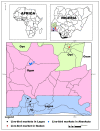Antimicrobial Resistance and Virulence of Methicillin-Resistant Staphylococcus aureus from Human, Chicken and Environmental Samples within Live Bird Markets in Three Nigerian Cities
- PMID: 32911712
- PMCID: PMC7558163
- DOI: 10.3390/antibiotics9090588
Antimicrobial Resistance and Virulence of Methicillin-Resistant Staphylococcus aureus from Human, Chicken and Environmental Samples within Live Bird Markets in Three Nigerian Cities
Abstract
Background: Methicillin-resistant Staphylococcus aureus (MRSA) has emerged as a major threat to public health. This study investigated the occurrence of MRSA in humans, chickens, chicken meat and environmental samples within poultry farms and live bird markets in southwestern Nigeria. Methods: MRSA were isolated using selective culture and tested for antimicrobial susceptibility by broth microdilution. Selected isolates were characterized by whole genome sequencing (WGS). From WGS data, spa, dru, multilocus sequence typing (MLST) and SCCmec types, but also virulence and antimicrobial resistance genes, were identified. Results: Fifty-six MRSA isolates were detected in 734 samples. They showed resistance to β-lactams (100%), tetracycline (60.7%), ciprofloxacin (33.9%), erythromycin (28.6%), gentamicin (32.1%), and trimethoprim/sulfamethoxazole (10.7%). All 30 isolates investigated by WGS carried mecA, dfrG, and tet(38) genes. Other resistance genes detected were blaZ (83.3%), fosB (73.3%), tet(K) (60.0%), aacA-aphD (36.6%), aphA3 (33.3%), msr(A) (30.0%), mph(C) (30.0%), dfrS1 (3.3%), and sat4 (3.3%). Seven spa types (t091, t314, t657, t1476, t2331, t4690 and t12236), four known (dt9aw, dt10ao, dt10cj, and dt11a) and two novel (dt10dr and dt11dw) dru types, as well as five sequence types (ST8, ST121, ST152, ST772 and ST789) were found among the MRSA isolates. All ST121 isolates carried an SCCmec type IV cassette and were not dru-typeable. ST152 and ST121 were found only in specific sample categories within defined locations, while ST8 and ST772 were distributed across most sample categories and locations. Three SCCmec types, IVa, V and Vc, were identified. All MRSA isolates possessed virulence genes including aur, clpP, coa, fnbA, esaA, hly, hla, ica, isdA, srtB, sspA, and vWbp, among others. The toxic shock syndrome toxin gene (tst) was not detected in any isolate, whereas the Pantone-Valentine leukocidin genes lukF-PV/lukS-PV were present in all ST121, all ST772, and all but one ST152 isolates. Conclusion: The results of this study (i) showed that chicken meat is contaminated by MRSA and (ii) suggested that live bird markets may serve as focal points for the dissemination of MRSA within the community.
Keywords: CA-MRSA; Nigeria; SCCmec; dru types; multidrug resistance; resistance genes; sequence types; spa types; virulence genes.
Conflict of interest statement
The authors declare no conflict of interest.
Figures


References
-
- Rahman M.M., Amin K.B., Rahman S., Khair A., Rahman M., Hossain A., Rahman A., Parvez M.S., Miura N., Alam M.M. Investigations of methicillin-resistant Staphylococcus aureus among clinical isolates from humans and animals by culture methods and multiplex PCR. BMC Vet. Res. 2018;14:300. doi: 10.1186/s12917-018-1611-0. - DOI - PMC - PubMed
-
- Fritz S.A., Hogan P.G., Singh L.N., Thompson R.M., Wallace M.A., Whitney K., Al-Zubeidi D., Burnham C.A., Fraser V.J. Staphylococcus aureus contamination of environmental surfaces in households with children infected with methicillin-resistant S. aureus. JAMA Pediatr. 2014;168:1030–1038. doi: 10.1001/jamapediatrics.2014.1218. - DOI - PMC - PubMed
Grants and funding
LinkOut - more resources
Full Text Sources
Research Materials
Miscellaneous

